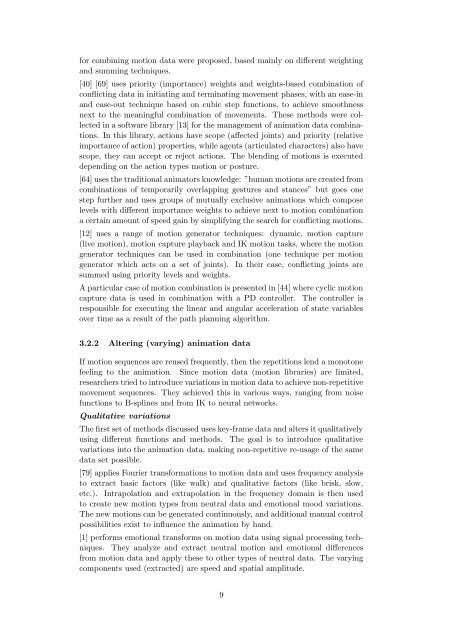Computer Animation for Articulated 3D Characters
Computer Animation for Articulated 3D Characters
Computer Animation for Articulated 3D Characters
You also want an ePaper? Increase the reach of your titles
YUMPU automatically turns print PDFs into web optimized ePapers that Google loves.
<strong>for</strong> combining motion data were proposed, based mainly on different weighting<br />
and summing techniques.<br />
[40] [69] uses priority (importance) weights and weights-based combination of<br />
conflicting data in initiating and terminating movement phases, with an ease-in<br />
and ease-out technique based on cubic step functions, to achieve smoothness<br />
next to the meaningful combination of movements. These methods were collected<br />
in a software library [13] <strong>for</strong> the management of animation data combinations.<br />
In this library, actions have scope (affected joints) and priority (relative<br />
importance of action) properties, while agents (articulated characters) also have<br />
scope, they can accept or reject actions. The blending of motions is executed<br />
depending on the action types motion or posture.<br />
[64] uses the traditional animators knowledge: ”human motions are created from<br />
combinations of temporarily overlapping gestures and stances” but goes one<br />
step further and uses groups of mutually exclusive animations which compose<br />
levels with different importance weights to achieve next to motion combination<br />
a certain amount of speed gain by simplifying the search <strong>for</strong> conflicting motions.<br />
[12] uses a range of motion generator techniques: dynamic, motion capture<br />
(live motion), motion capture playback and IK motion tasks, where the motion<br />
generator techniques can be used in combination (one technique per motion<br />
generator which acts on a set of joints). In their case, conflicting joints are<br />
summed using priority levels and weights.<br />
A particular case of motion combination is presented in [44] where cyclic motion<br />
capture data is used in combination with a PD controller. The controller is<br />
responsible <strong>for</strong> executing the linear and angular acceleration of state variables<br />
over time as a result of the path planning algorithm.<br />
3.2.2 Altering (varying) animation data<br />
If motion sequences are reused frequently, then the repetitions lend a monotone<br />
feeling to the animation. Since motion data (motion libraries) are limited,<br />
researchers tried to introduce variations in motion data to achieve non-repetitive<br />
movement sequences. They achieved this in various ways, ranging from noise<br />
functions to B-splines and from IK to neural networks.<br />
Qualitative variations<br />
The first set of methods discussed uses key-frame data and alters it qualitatively<br />
using different functions and methods. The goal is to introduce qualitative<br />
variations into the animation data, making non-repetitive re-usage of the same<br />
data set possible.<br />
[79] applies Fourier trans<strong>for</strong>mations to motion data and uses frequency analysis<br />
to extract basic factors (like walk) and qualitative factors (like brisk, slow,<br />
etc.). Intrapolation and extrapolation in the frequency domain is then used<br />
to create new motion types from neutral data and emotional mood variations.<br />
The new motions can be generated continuously, and additional manual control<br />
possibilities exist to influence the animation by hand.<br />
[1] per<strong>for</strong>ms emotional trans<strong>for</strong>ms on motion data using signal processing techniques.<br />
They analyze and extract neutral motion and emotional differences<br />
from motion data and apply these to other types of neutral data. The varying<br />
components used (extracted) are speed and spatial amplitude.<br />
9















